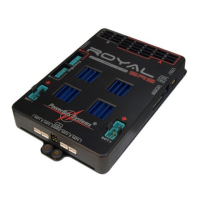31
up, the left aileron down. If the control surfaces respond in the opposite direction, you must
reverse the direction of gyro effect by setting the DIRECTION point to REVERSE. Ensure that
both ailerons move in the correct direction; if your model has two aileron channels, AILERON-B
must also be set correctly.
Note: naturally, this has no effect on the direction of control when you operate the transmitter
sticks!
IV) Before you fly the model, set both gain adjusters on the transmitter to 0%, and the flight mode
switch to FM:1. Before the flight remind yourself again of the controls you have selected.
The flight mode switch is very important during the set-up phase, because it can be used to
disable the iGyro immediately if any setting is incorrect: all you have to do is switch to flight
mode 1.
It is also important to select rotary control(s) or slider(s) on the transmitter which are easy to
reach and adjust while the model is flying.
If you are using the GPS Sensor, it is important to check that the GPS Sensor status on the
main screen displays OK before you fly the model.
V) We recommend that you fly the model parallel to the runway after taking off, and then move
the flight mode switch to position 2. The model should be at a safe height - but not too high, as
you must be able to see the model very clearly. The model’s speed should also be no more than
average, otherwise the GPS sensor will have a marked damping effect on the gyro. An ideal
starting point is a straight, level pass at quarter-throttle. Slowly turn up or advance the Normal
gain adjuster to the point where the model just starts oscillating slightly. When you reach this
point, turn the adjuster back slightly.
Note: it is essential to leave the Heading mode adjuster at 0% at this stage, as the aim is to
ensure that only Normal gain has effect in all phases of the flight; this makes it possible to
adjust the value accurately.
If Heading gain is set to 0%, the integral iGyro works in Normal mode all the time.
VI) By now the model should already be flying much more smoothly. Carry out another pass, this
time at maximum speed, to find out if the damping effect of the GPS Sensor is adequate. If the
model starts to oscillate at top speed, we recommend that you land the model and alter the
AIRSPEED FACTOR value for AILERON-A and AILERON-B (if using two aileron channels) to 3.
VII) If the model continues to fly stably at maximum speed, it is time to fly another pass in order to
adjust Heading gain: set the model flying straight and level, then leave the aileron stick alone.
Now turn up the associated adjuster for Heading gain until the model just begins to oscillate.
When that happens, back off on the adjuster slightly - and the job is done.
Important: we also want to adopt these settings in flight mode 3; this is accomplished by
briefly moving the flight mode switch to FM:3.
Note: in dead-calm conditions it is difficult to set up the gyro accurately, as it has little scope
for stabilising the model; the result is that oscillation does not set in until the gain settings are
very high.
However, it is possible to force the gyro to provide compensation by - for example - applying
a large rudder command to disturb the model’s flight path. When setting up the rudder it is a
good idea to fly a knife-edge pass in order to force the gyro to compensate.
At this stage it is perfectly safe to land the model with the iGyro switched on. You will be rewar-
ded with a stable landing approach which will immediately convince you of the iGyro’s effecti-
veness.

